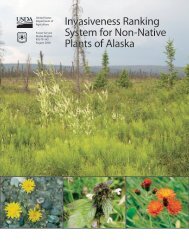ornamental jewelweed Impatiens glandulifera Royle
ornamental jewelweed Impatiens glandulifera Royle
ornamental jewelweed Impatiens glandulifera Royle
Create successful ePaper yourself
Turn your PDF publications into a flip-book with our unique Google optimized e-Paper software.
<strong>ornamental</strong> <strong>jewelweed</strong><strong>Impatiens</strong> <strong>glandulifera</strong> <strong>Royle</strong>Synonyms: <strong>Impatiens</strong> roylei Walp.Other common name: policemen’s helmet, Himalayan balsam, Washington orchidFamily: BalsaminaceaeInvasiveness Rank: 82 The invasiveness rank is calculated based on a species’ ecological impacts, biologicalattributes, distribution, and response to control measures. The ranks are scaled from 0 to 100, with 0 representing aplant that poses no threat to native ecosystems and 100 representing a plant that poses a major threat to nativeecosystems.DescriptionOrnamental <strong>jewelweed</strong> is an annual plant that growsfrom 91 to 152 ½ cm tall. Stems are erect, hollow,smooth, hairless, reddish, and multi-branched withlarge, swollen nodes. Leaves are large, simple, ovate toelliptic, 15 cm long, 7 ½ cm wide, and opposite(although they occasionally form whorls of 3) withsharply toothed margins. Flowers grow in sparseclusters from the leaf axils. They are irregular and havefive petals each. They can be white, pink, red, or purple.Capsules burst open explosively at maturity whentouched. Seeds are large, 3 to 5 mm, and black atmaturity (Lid and Lid 1994, King County 2004).growth of and eventually displace native plant species(King County 2004, Prots and Klotz 2004). Thepresence of <strong>ornamental</strong> <strong>jewelweed</strong> alters thecomposition and behavior of pollinating insects.Pollinators of <strong>ornamental</strong> <strong>jewelweed</strong> include severalspecies of bumblebees, honeybees, moths, and wasps(Beerling and Perrins 1993, Chittka and Schürkens2001, King County 2004). Ornamental <strong>jewelweed</strong>negatively impacts the habitats of wildlife species.Because of their high holocellulose contents, the stemspersist as litter during the following spring, suppressingthe seedlings of other plant species (Beerling andPerrins 1993).Impact on ecosystem processes: At high densities,<strong>ornamental</strong> <strong>jewelweed</strong> can alter water flow, increaseerosion, and cause flooding (King County 2004).<strong>Impatiens</strong> <strong>glandulifera</strong> <strong>Royle</strong>. Photo by B. Tokarska-Guzik.Similar species: No other plants are likely to beconfused with <strong>ornamental</strong> <strong>jewelweed</strong>. The nativewestern touch-me-not (<strong>Impatiens</strong> noli-tangere) can bedistinguished from <strong>ornamental</strong> <strong>jewelweed</strong> by thepresence of yellow flowers (Hultén 1968).Ecological ImpactImpact on community composition, structure, andinteractions: Ornamental <strong>jewelweed</strong> can reduce the<strong>Impatiens</strong> <strong>glandulifera</strong> <strong>Royle</strong> infestation in Alaska. Photo by M.Shephard.Biology and Invasive PotentialReproductive potential: Ornamental <strong>jewelweed</strong>reproduces by seeds only. Each plant can produce from800 to 2,500 seeds. Seeds remain viable for 18 monthsor more. They can geminate under water (King County2004).Role of disturbance in establishment: Ornamental<strong>jewelweed</strong> requires a moderate amount of localdisturbance and exposed soil to establish successfullyLast Updated: 2011-02-07 by Helen Kleinhttp://aknhp.uaa.alaska.edu
(Beerling and Perrins 1993).Potential for long-distance dispersal: Seeds are ejectedup to 6 meters from mature capsules. They can betransported along waterways or dispersed by smallmammals (King County 2004). The rate of spread inBritain was estimated at 2 to 5 km per year (Beerlingand Perrins 1993).Potential to be spread by human activity: Ornamental<strong>jewelweed</strong> is frequently planted as a garden <strong>ornamental</strong>(King County 2004). It has been widely planted ingardens in south-central and southeast Alaska.Germination requirements: Seeds require coldstratification to break dormancy. They usuallygerminate in late spring. The best germination responseoccurs when seeds are stored at 5°C (Mumford 1988,Beerling Perrins 1993, King County 2004).Growth requirements: Ornamental <strong>jewelweed</strong> is tolerantof many soil types. It grows on fine and coarsealluvium, maritime shingle, free-draining mineral soils,and peats. It can tolerate both nutrient-rich and nutrientpoorsoils. It grows best in soil that has a pH between3.4 and 7.7. It is partially shade tolerant. Plants of allages are sensitive to frost (Beerling Perrins 1993).Congeneric weeds: Buzzy lizzy (<strong>Impatiens</strong> walleriana)is considered an invasive weed in Hawaii (USDA 2002).Smallflower touch-me-not (<strong>Impatiens</strong> parviflora), whichis native to East Asia, is an invasive weed in northernEurope (Lid and Lid 1994).Legal ListingsHas not been declared noxiousListed noxious in AlaskaListed noxious by other states (CT, OR, WA)Federal noxious weedListed noxious in Canada or other countriesDistribution and AbundanceOrnamental <strong>jewelweed</strong> grows in riparian areas, wetmeadows, moist forests, stream sides, and roadsideReferences:Chittka L. and S. Schürkens. 2001. Successful invasionof a floral market. Nature 411: 653.Beerling, D.J. and J.M. Perrins. 1993. Biological Floraof the British Isles. <strong>Impatiens</strong> <strong>glandulifera</strong><strong>Royle</strong> (<strong>Impatiens</strong> roylei Walp). Journal ofEcology. Vol 81 (2): 367-382.Hitchcock, C.L. and A. Cronquist. 1973. Flora of thePacific Northwest An illustrated manual.University of Washington Press. Seattle andLondon. 730 pp.Hultén, E. 1968. Flora of Alaska and NeighboringTerritories. Stanford University Press, Stanford,CA. 1008 pp.Invaders Database System. 2010. University ofMontana. Missoula, MT.ditches. It is planted in gardens and parks (Beerling andPerrins 1993, Lid and Lid 1994, King County 2004).Native and current distribution: Native to the westernHimalayas, <strong>ornamental</strong> <strong>jewelweed</strong> has naturalized in 31countries. It is widespread in Europe, North America,and Asia between the latitudes of 30°N and 64°N(Beerling and Perrins 1993, Lid and Lid 1994, Prots andKlotz 2004). Ornamental <strong>jewelweed</strong> has been recordedin California, Connecticut, Idaho, Maine,Massachusetts, Michigan, Montana, New York, Oregon,Vermont, Washington, and several Canadian provinces(Hitchcock and Cronquist 1973, USDA 2002). Its rangein North America is rapidly expanding (Prots and Klotz2004). In Alaska, <strong>ornamental</strong> <strong>jewelweed</strong> has beenrecorded from Anchorage and Haines (Weeds of AlaskaDatabase 2004).Pacific MaritimeInterior- BorealArctic-AlpineCollection SiteDistribution of <strong>ornamental</strong> <strong>jewelweed</strong> in AlaskaManagementSmall populations can be hand-pulled or dug up. Sitesshould be monitored the following year for newseedlings from the seed bank. Mowing is very effectiveand causes less erosion than hand-pulling, but mowed orcut plants may resprout later in the season. A restrictedset of herbicides can be used to control infestations inwetlands. No biological control agents have beenidentified (King County 2004).http://invader.dbs.umt.edu/King County. 2004. Policemen’s helmet <strong>Impatiens</strong><strong>glandulifera</strong>. Department of Natural Resourcesand Parks, Water, and Land Resources DivisionNoxious Weed Control Program. 206296-0290TTY Relay: 711. Available:http://dnr.metrokc.gov/wlr/LANDS/Weeds/impatiens.htm [November 2, 2004].Lid, J. and D. T. Lid. 1994. Flora of Norway. TheNorske Samlaget, Oslo. Pp. 1014.Mumford, P.M. 1988. Alleviation and induction ofdormancy by temperature in <strong>Impatiens</strong><strong>glandulifera</strong> <strong>Royle</strong>. Now Phytologist, 109:107-110.Last Updated: 2011-02-07 by Helen Kleinhttp://aknhp.uaa.alaska.edu
Prots, B. and S. Klotz. 2004. The invasion ecology ofHimalayan Balsam (<strong>Impatiens</strong> <strong>glandulifera</strong><strong>Royle</strong>). UFZ Centre for EnvironmentalResearch. Leipzig. Available:http://www.hdg.ufz.de/index.php?en=1094[November 2, 2004].USDA (United States Department of Agriculture),NRCS (Natural Resource ConservationService). 2002. The PLANTS Database,Version 3.5 (http://plants.usda.gov). NationalPlant Data Center, Baton Rouge, LA 70874-4490 USA.Weeds of Alaska Database. 2004. AKEPIC MappingProject Inventory Field Data. Alaska NaturalHeritage Program, University of Alaska – USForest Service – National Park Service.Available: http://akweeds.uaa.alaska.edu/Last Updated: 2011-02-07 by Helen Kleinhttp://aknhp.uaa.alaska.edu
















